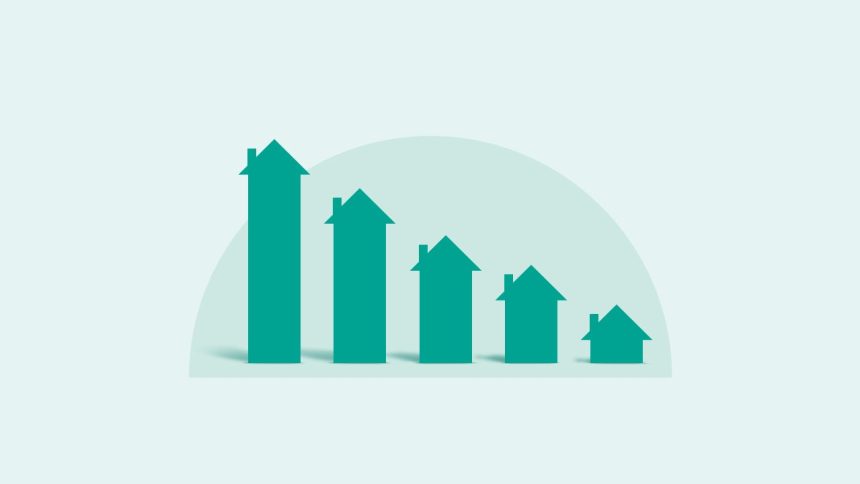Key takeaways
- Home equity rates are determined by both macroeconomic factors, like the Federal Reserve’s monetary policy, and the borrower’s financial profile.
- Home equity loan and HELOCs rates are based on a benchmark interest rate (the “index”), plus an additional amount set by the lender (the “margin”).
- Lenders evaluate a borrower’s credit score, amount of home equity, loan amount, loan term, and type of property to determine their rate offer.
- A home equity loan works more like a traditional mortgage, with a fixed interest rate, while a HELOC has a variable rate that changes over time.
If you’re thinking about borrowing against your home with a HELOC or a home equity loan, your first question is probably: “What will my interest rate be?” Followed up by a second: “How is that rate determined?”
The truth is, home equity rates are shaped by a couple of factors: some big-picture economic forces, along with your personal financial details. Understanding the influences that set your rate can help you make smarter borrowing decisions and potentially save you thousands of dollars over the life of your loan.
So let’s parse how HELOC and home equity loan rates are determined.
Factors that shape your HELOC and home equity loan rates
Lenders don’t just pluck interest rates out of thin air. Macroeconomic factors – what’s going on in the economy and financial sector – heavily influence home equity rates.
Chief among them: the Federal Reserve’s actions. When the Fed raises or lowers the federal funds rate, the interest that banks charge each other for overnight loans, it creates a ripple effect among rates. It first impacts the prime rate, which is the benchmark most lenders use when setting interest rates for consumer products – like HELOCs (home equity lines of credit). You will typically see HELOC rates adjust a few weeks after the Fed moves interest rates.
The actual interest rate on an individual HELOC is based on two things: an index and a margin. The index is usually tied to a widely used benchmark rate (like the aforementioned prime rate). The margin is an extra amount the lender adds onto the benchmark rate. “The margin is predetermined by the lender and remains fixed, while the index can fluctuate with the broader economy,” says Vishal Garg, CEO of Better, an online lender headquartered in New York. “This structure allows rates to adjust over time in response to market conditions.”
For example: If the prime rate is 6.75% and the lender margin is 3%, your HELOC’s interest rate would be 9.75%. If the prime rate rose .25%, your interest rate would rise to 10%; if it fell by that amount, your rate would also fall, to 9.5%. But your interest rate would always be 3 percentage points above the prime.
As for home equity loan rates, they operate a bit differently. While the Fed funds rate may also influence them, home equity loans are primarily “shaped by bond market yields and broader interest rate trends,” explains Garg. In particular, the yield on the 10-year Treasury bond serves as a benchmark for lenders when pricing fixed-rate loans. (Of course, the bond yields themselves are sensitive to various economic indicators, including the Fed’s monetary policy and the pace of inflation.) On top of the benchmark rate, lenders then add an extra amount to compensate for their risk in providing credit.
How lenders set your HELOC or home equity loan rate
While broader economic trends influence general home equity rates, the individual rate you are offered is all about you. Lenders look at a number of your personal financial details to determine how risky it is to lend to you, and adjust the margin part of the interest rate accordingly. Simply put, the stronger your profile, the lower the rate and better terms you may receive. Here are some of the factors that lenders look at:
- Credit score and history: A high credit score and strong credit profile demonstrate your ability to manage your debts responsibly: You pay bills on time, don’t exceed your credit card limits, etc.
- Debt-to-income (DTI) ratio: This metric measures what’s going out each month vs. what’s coming in. A low debt-to-income ratio shows lenders that less of your earnings are committed towards paying obligations, and that you have a greater amount of discretionary income to spend.
- Combined loan-to-value ratio (CLTV): This measure compares how much your home-based debt is against the overall worth of your home, which acts as collateral for the loan. A lower CLTV (total of your mortgage plus the new loan or credit line, divided by your home’s value) indicates you are more financially stable, and represents less risk for the lender.
However, your finances aren’t the only factors that will influence the rate you are offered. Lenders will also evaluate the loan amount and the loan term. The type of property can also make a difference, as home equity lenders often view a primary residence as less risky than a second home or an investment property.
“Together, these inputs influence pricing tiers and determine whether the borrower qualifies for promotional, standard or risk-adjusted rates,” says Garg. That means if you have a strong credit history, DTI and CLTV, you might be able to snag a promotional teaser rate, which can be around three percentage points below “regular,” prevailing home equity rates. Some lenders may also offer small discounts for other things, like if you sign up for auto-payments and/or have another account with them.
Differences in HELOC and HELoan rate calculations
One big difference between a HELOC and a home equity loan is how the interest is calculated.
HELOCs usually have variable interest rates, which means your APR (annual percentage rate) can change over time. That rate is based on the prime rate. When that goes up or down, your HELOC rate and your monthly payment will follow suit. While HELOCs can give homeowners flexibility in drawing and repaying funds, the adjustable rate makes your monthly costs unpredictable, and they can easily rise over the HELOC’s lifetime.
On the other hand, a home equity loan works more like a traditional mortgage: You receive a lump sum upfront at a fixed interest rate. The loan is amortized over a set term, sometimes as long as 30 years, and you repay it in equal monthly installments. While not as flexible as HELOCs, home equity loans can be easier to budget for, since your payments stay constant each month.
How to get the best HELOC or home equity loan rate
If you want the best rate on a HELOC or home equity loan, start by strengthening your financial profile. The more equity you’ve built up, and the more of your mortgage you’ve paid off, the better your chances of landing a lower rate. Also, make sure your credit report is clean and free of errors. Try to strengthen it by paying down balances and avoiding late payments.
It also pays to shop around. Don’t just sign up with your current bank or mortgage company, though it can be a good starting point. Compare offers from at least three institutions, including retail banks (national or regional), credit unions/thrifts and online lenders. Pay attention not just to the loan or credit line’s interest rate, but to the APR (annual percentage rate), which will reflect all the fees and closing costs you’ll pay. With HELOCs in particular, ask about introductory rates (and when they’ll reset), annual fees, prepayment penalties and minimum draw requirements. All of this will affect how much the HELOC or home equity loan really costs you over time.
Read the full article here
















